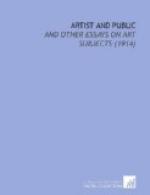When the Franco-Prussian War broke out Paris ceased to be a place for the carrying on of the serious study of art, and Saint-Gaudens went to Rome, where his associates were the French prizemen of the day, of whom Mercie was one. He remained there until 1874, except for a visit to New York in the winter of 1872-3 for the purpose of modelling a bust of Senator Evarts, and one or two other busts, which were put into marble upon his return to Rome. In those Roman days he executed his first statue, a “Hiawatha,” one of his few studies of the nude, and a “Silence,” a not very characteristic draped figure which yet fills with some impressiveness her niche at the head of the grand stairway of the Masonic Temple on Twenty-fourth Street.
From 1875 to 1877 he had a studio in New York, where he seems to have executed some of his earliest portrait reliefs. During these years he came into contact with La Farge, for whom he turned painter and aided in the execution of the decorations of Trinity Church in Boston. It was at this time, also, that he received his first commissions for important public work, those for the Farragut statue in Madison Square, the Randall at Sailors’ Snug Harbor, and the angels for Saint Thomas’s Church. He had married Augusta F. Homer in 1877, and in that year, taking his bride and his commissions with him, he returned to Paris, feeling, as many another young Paris-bred artist has felt, that there only could such important works be properly carried out. The “Farragut” was completed and exhibited in the plaster at the Salon of 1880, and from that time his success was assured. For the rest of his life he was constantly busy, receiving almost more commissions for work of importance than it was possible for him to carry out. He returned to New York in 1880, and in 1881 he opened the studio in Thirty-sixth Street, where he remained for sixteen years and where so many of his greatest works were executed. From that studio came many of his exquisite portraits in relief, his caryatids and angelic figures, such as those for the Morgan tomb, so unfortunately destroyed by fire in 1882 (a fate since shared by the earlier angels of Saint Thomas’s), the great statues of Lincoln and Chapin, the “Shaw Memorial,” and the “Adams Memorial”; and in it was done all the preliminary work of the great equestrian monument to General Sherman.
It is in these years of his prime that he will ever be most fondly remembered by those—and they are many—who had the privilege of his friendship. Admittedly our foremost sculptor, and one of the founders of the Society of American Artists, he became at once a person of importance in the world of art; and as his brilliant career developed he established intimate relationships with an ever-widening circle of men in every walk of life, while no one who ever knew him well can have felt anything but an abiding affection for him. That long, white studio became a familiar meeting-place for all who were interested in any form of art; and the Sunday afternoon concerts that were held there for many years will be looked back to with regret as long as any of their auditors remain alive.




